Abstract
An acute depletion of plasma fibronectin or FN has been observed in critically ill, surgical, or trauma patients, but there is little information on the relationships between FN levels and the final outcome in such cases, and on the simultaneous behaviour of other serum proteins. The daily values of FN, antithrombin III, IgG, C3, prealbumin, and transferrin were monitored in 98 intensive care patients after major elective surgery or trauma. According to their clinical course, they were divided retrospectively into three groups. Group A (33 patients) had sepsis. Group B (31 patients) had nonseptic complications, and group C (34 patients) had no complications in the ICU. The individual, nadir levels of FN, AT III, prealbumin, and transferrin were lower (p less than 0.01) in the septic group A than in B and C. Within the septic group, the nadir levels of AT III, but not those of FN, were lower (p less than 0.01) in the 14 nonsurvivors than in the 19 survivors. The FN and AT III levels had returned at least temporarily to the normal range in the six ultimate fatalities from sepsis who survived for more than two weeks. In the septic group, transferrin showed the highest percentages of actually subnormal levels and differed from FN in this respect with p less than 0.05. Furthermore, all six proteins showed a significant overall pattern (p less than 0.01) of parallel variations. The results confirm other reports on the behavior of fibronectin in septic patients as a group, but it was not informative as to the individual outcome, and its reduction might be viewed as part of a general plasma protein depletion associated with acute septic disease. This pattern is probably attributable to a combination of intravascular consumption and an overall excess of protein catabolism over synthesis.
Full text
PDF

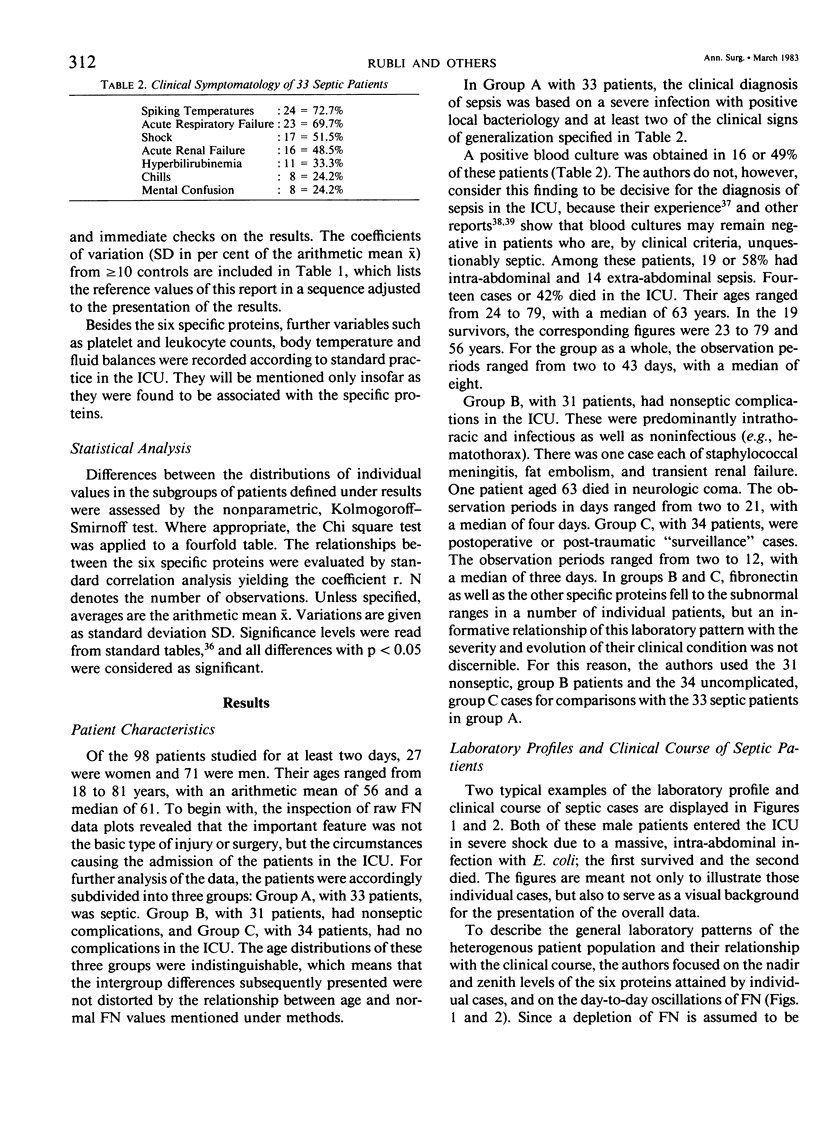
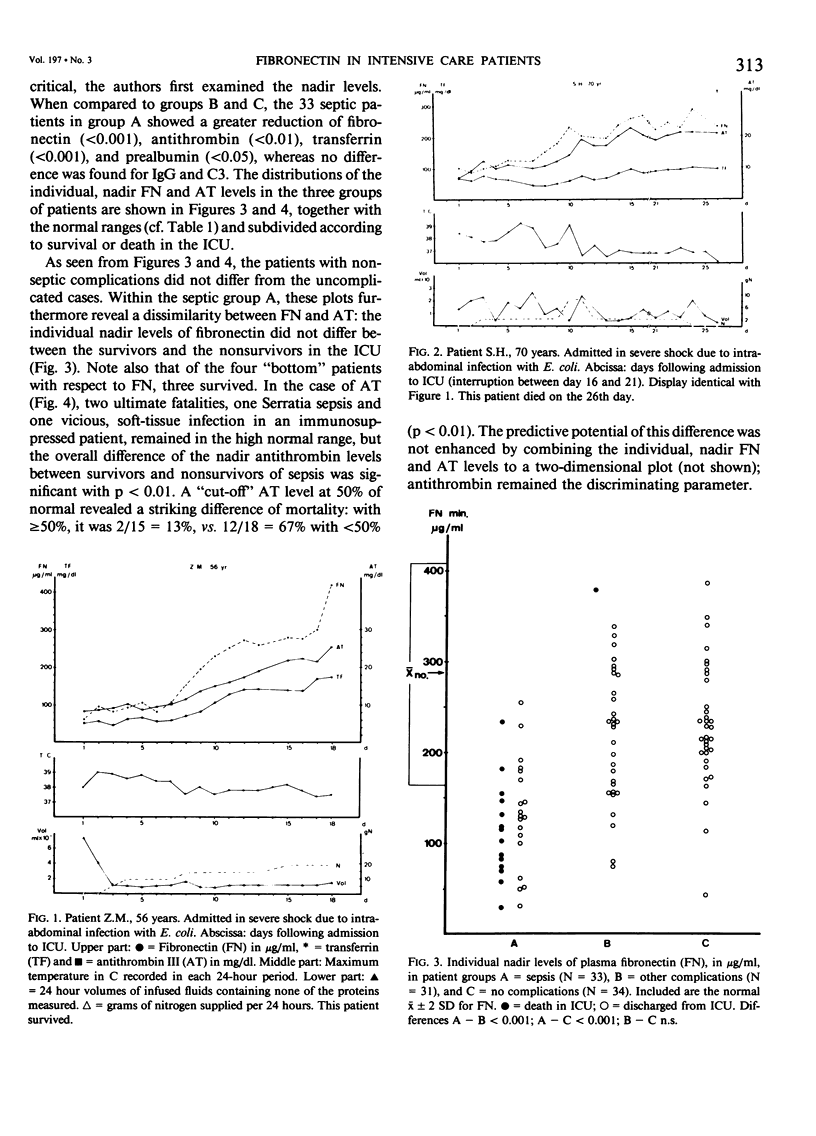
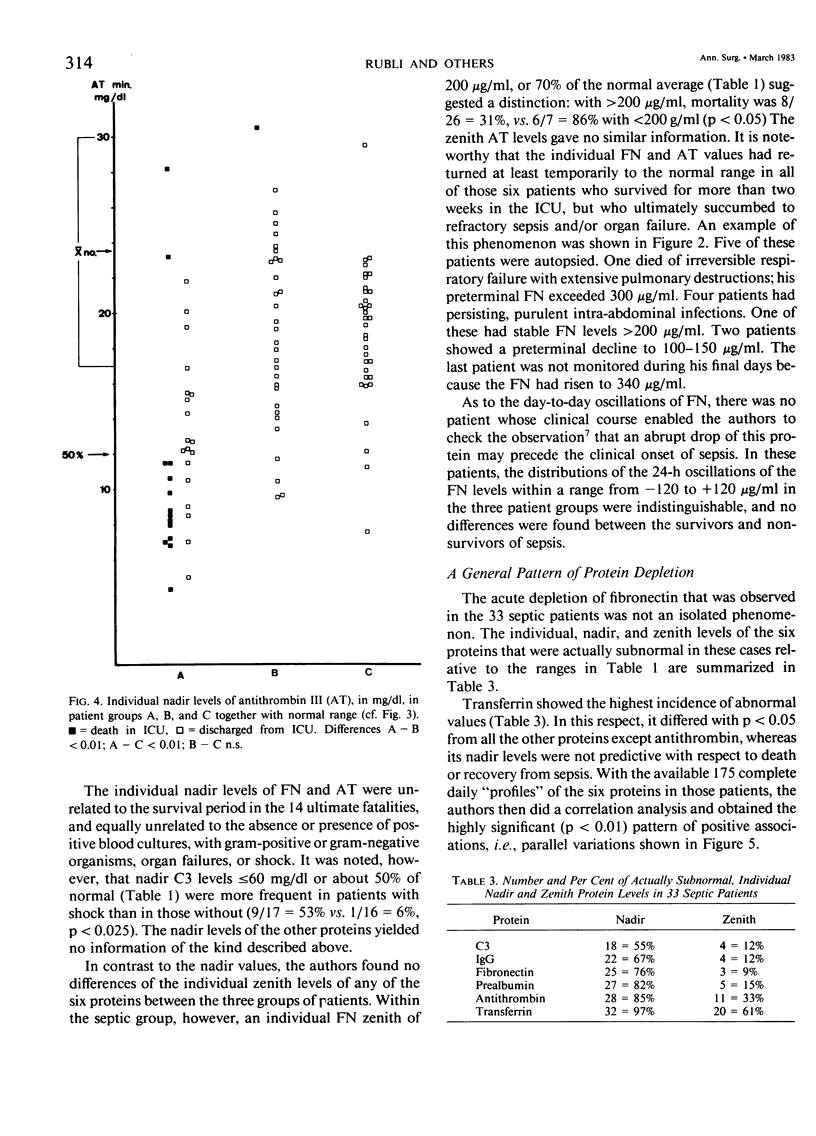
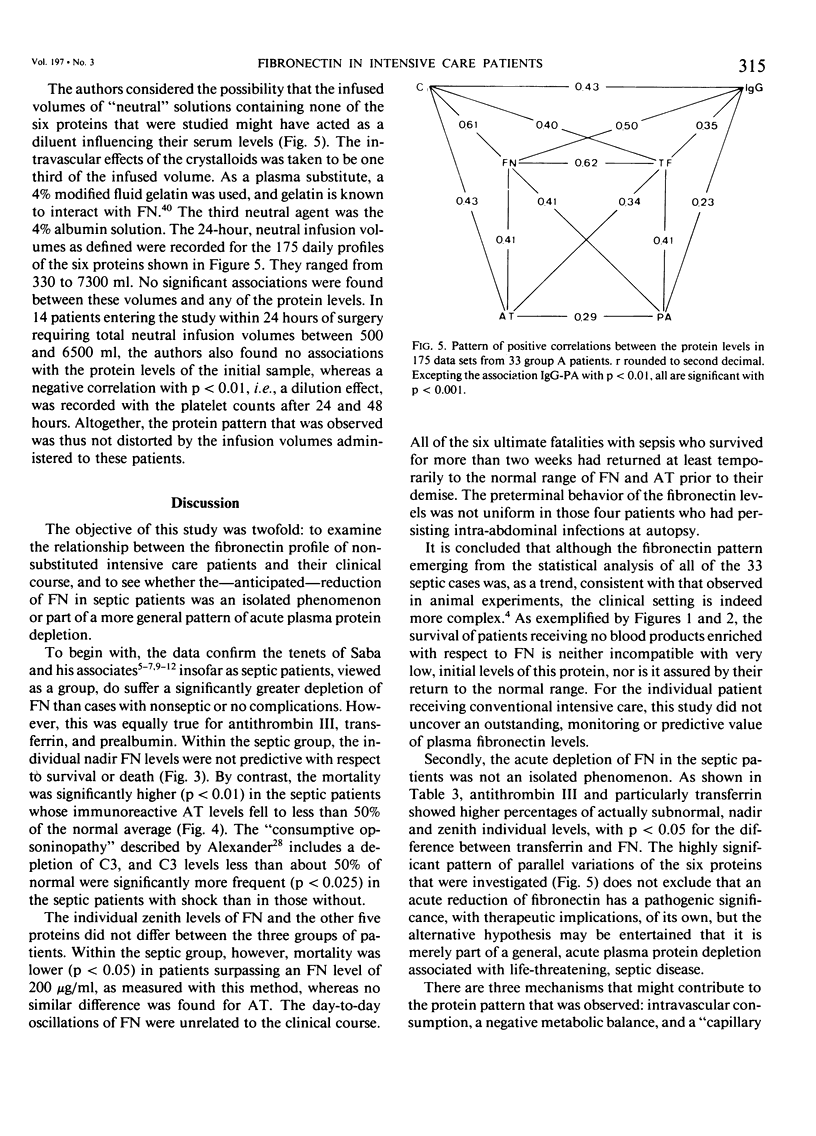
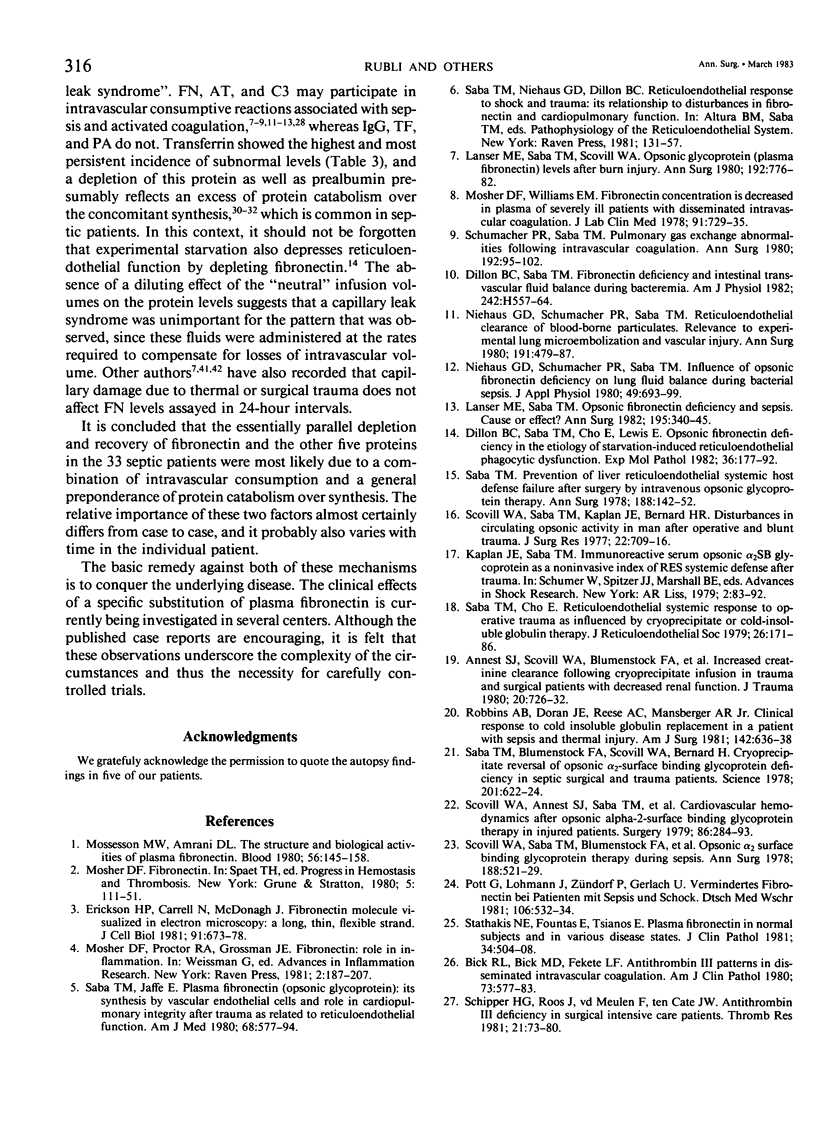
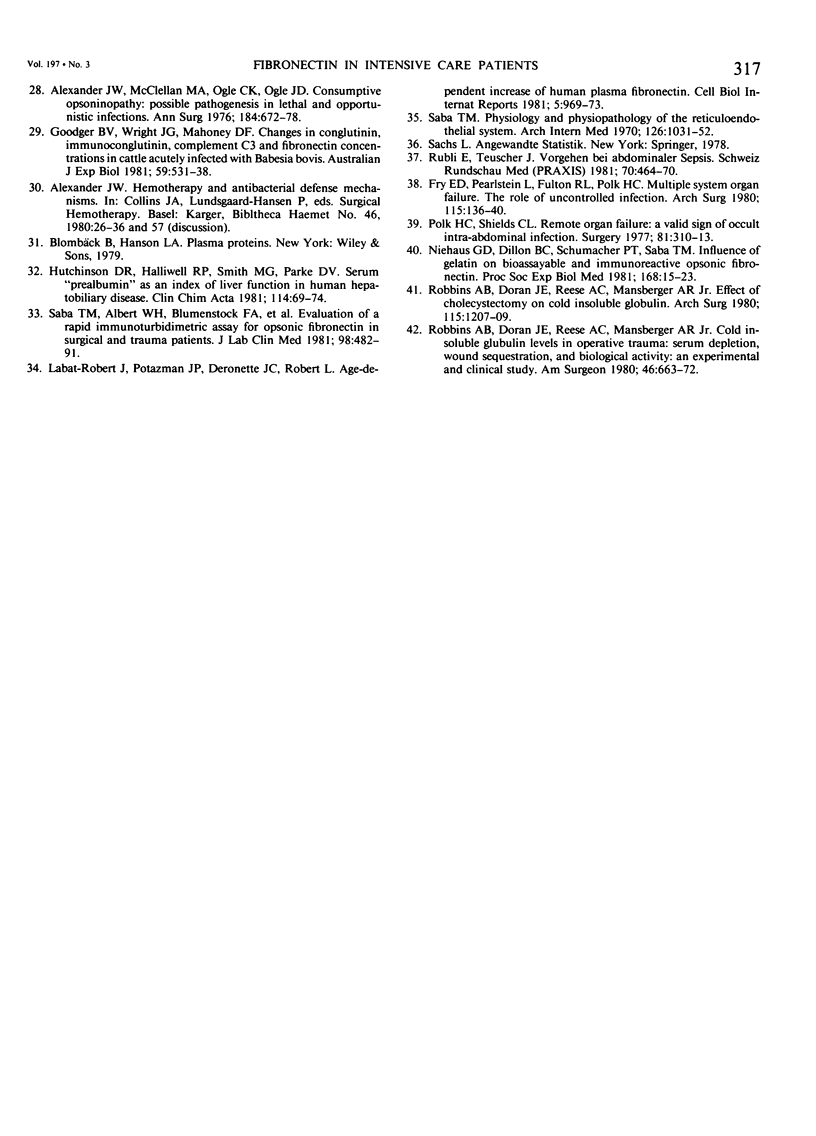
Selected References
These references are in PubMed. This may not be the complete list of references from this article.
- Alexander J. W., McClellan M. A., Ogle C. K., Ogle J. D. Consumptive opsoninopathy: possible pathogenesis in lethal and opportunistic infections. Ann Surg. 1976 Dec;184(6):672–678. doi: 10.1097/00000658-197612000-00002. [DOI] [PMC free article] [PubMed] [Google Scholar]
- Annest S. J., Scovill W. A., Blumenstock F. A., Stratton H. H., Newell J. C., Paloski W. H., Saba T. M., Powers S. R. Increased creatinine clearance following cryoprecipitate infusion in trauma and surgical patients with decreased renal function. J Trauma. 1980 Sep;20(9):726–732. doi: 10.1097/00005373-198009000-00003. [DOI] [PubMed] [Google Scholar]
- Bick R. L., Bick M. D., Fekete L. F. Antithrombin III patterns in disseminated intravascular coagulation. Am J Clin Pathol. 1980 Apr;73(4):577–583. doi: 10.1093/ajcp/73.4.577. [DOI] [PubMed] [Google Scholar]
- Dillon B. C., Saba T. M., Cho E., Lewis E. Opsonic fibronectin deficiency in the etiology of starvation-induced reticuloendothelial phagocytic dysfunction. Exp Mol Pathol. 1982 Apr;36(2):177–192. doi: 10.1016/0014-4800(82)90092-2. [DOI] [PubMed] [Google Scholar]
- Dillon B. C., Saba T. M. Fibronectin deficiency and intestinal transvascular fluid balance during bacteremia. Am J Physiol. 1982 Apr;242(4):H557–H564. doi: 10.1152/ajpheart.1982.242.4.H557. [DOI] [PubMed] [Google Scholar]
- Erickson H. P., Carrell N., McDonagh J. Fibronectin molecule visualized in electron microscopy: a long, thin, flexible strand. J Cell Biol. 1981 Dec;91(3 Pt 1):673–678. doi: 10.1083/jcb.91.3.673. [DOI] [PMC free article] [PubMed] [Google Scholar]
- Fry D. E., Pearlstein L., Fulton R. L., Polk H. C., Jr Multiple system organ failure. The role of uncontrolled infection. Arch Surg. 1980 Feb;115(2):136–140. doi: 10.1001/archsurg.1980.01380020006003. [DOI] [PubMed] [Google Scholar]
- Goodger B. V., Wright I. G., Mahoney D. F. Changes in conglutinin, immunoconglutinin, complement C3 and fibronectin concentrations in cattle acutely infected with Babesia bovis. Aust J Exp Biol Med Sci. 1981 Oct;59(Pt 5):531–538. doi: 10.1038/icb.1981.46. [DOI] [PubMed] [Google Scholar]
- Hutchinson D. R., Halliwell R. P., Smith M. G., Parke D. V. Serum "prealbumin" as an index of liver function in human hepatobiliary disease. Clin Chim Acta. 1981 Jul 18;114(1):69–74. doi: 10.1016/0009-8981(81)90229-1. [DOI] [PubMed] [Google Scholar]
- Kaplan J. E., Saba T. M. Immunoreactive serum opsonic alpha 2 sb glycoprotein as a noninvasive index of RES systemic defense after trauma. Adv Shock Res. 1979;2:83–92. [PubMed] [Google Scholar]
- Labat-Robert J., Potazman J. P., Derouette J. C., Robert L. Age-dependent increase of human plasma fibronectin. Cell Biol Int Rep. 1981 Oct;5(10):969–973. doi: 10.1016/0309-1651(81)90213-7. [DOI] [PubMed] [Google Scholar]
- Lanser M. E., Saba T. M. Opsonic fibronectin deficiency and sepsis. Cause or effect? Ann Surg. 1982 Mar;195(3):340–345. doi: 10.1097/00000658-198203000-00015. [DOI] [PMC free article] [PubMed] [Google Scholar]
- Lanser M. E., Saba T. M., Scovill W. A. Opsonic glycoprotein (plasma fibronectin) levels after burn injury. Relationship to extent of burn and development of sepsis. Ann Surg. 1980 Dec;192(6):776–782. doi: 10.1097/00000658-198012000-00014. [DOI] [PMC free article] [PubMed] [Google Scholar]
- Mosesson M. W., Amrani D. L. The structure and biologic activities of plasma fibronectin. Blood. 1980 Aug;56(2):145–158. [PubMed] [Google Scholar]
- Mosher D. F. Fibronectin. Prog Hemost Thromb. 1980;5:111–151. [PubMed] [Google Scholar]
- Mosher D. F., Williams E. M. Fibronectin concentration is decreased in plasma of severely ill patients with disseminated intravascular coagulation. J Lab Clin Med. 1978 May;91(5):729–735. [PubMed] [Google Scholar]
- Niehaus G. D., Dillon B. C., Schumacker P. T., Saba T. M. Influence of gelatin on bioassayable and immunoreactive opsonic fibronectin. Proc Soc Exp Biol Med. 1981 Oct;168(1):15–23. doi: 10.3181/00379727-168-41228. [DOI] [PubMed] [Google Scholar]
- Niehaus G. D., Schumacker P. R., Saba T. M. Reticuloendothelial clearance of blood-borne particulates: relevance to experimental lung microembolization and vascular injury. Ann Surg. 1980 Apr;191(4):479–487. doi: 10.1097/00000658-198004000-00015. [DOI] [PMC free article] [PubMed] [Google Scholar]
- Niehaus G. D., Schumacker P. T., Saba T. M. Influence of opsonic fibronectin deficiency on lung fluid balance during bacterial sepsis. J Appl Physiol Respir Environ Exerc Physiol. 1980 Oct;49(4):693–699. doi: 10.1152/jappl.1980.49.4.693. [DOI] [PubMed] [Google Scholar]
- Polk H. C., Jr, Shields C. L. Remote organ failure: a valid sign of occult intra-abdominal infection. Surgery. 1977 Mar;81(3):310–313. [PubMed] [Google Scholar]
- Pott G., Lohmann J., Zündorf P., Gerlach U. Vermindertes Fibronectin im Plasma bei Patienten mit Sepsis und Schock. Epiphänomen oder Zeichen verminderter Funktion des retikuloendothelialen Systems? Dtsch Med Wochenschr. 1981 Apr 24;106(17):532–534. doi: 10.1055/s-2008-1070350. [DOI] [PubMed] [Google Scholar]
- Robbins A. B., Doran J. E., Reese A. C., Mansberger A. R., Jr Clinical response to cold insoluble globulin replacement in a patient with sepsis and thermal injury. Am J Surg. 1981 Nov;142(5):636–638. doi: 10.1016/0002-9610(81)90443-8. [DOI] [PubMed] [Google Scholar]
- Robbins A. B., Doran J. E., Reese A. C., Mansberger A. R., Jr Cold insoluble globulin levels in operative trauma: serum depletion, wound sequestration, and biological activity: an experimental and clinical study. Am Surg. 1980 Dec;46(12):663–672. [PubMed] [Google Scholar]
- Robbins A. B., Doran J. E., Reese A. C., Mansberger A. R., Jr Effect of cholecystectomy on cold insoluble globulin. Arch Surg. 1980 Oct;115(10):1207–1209. doi: 10.1001/archsurg.1980.01380100053012. [DOI] [PubMed] [Google Scholar]
- Rubli E., Teuscher J. Vorgehen bei abdominaler sepsis. Schweiz Rundsch Med Prax. 1981 Mar 10;70(11):464–470. [PubMed] [Google Scholar]
- Saba T. M., Albert W. H., Blumenstock F. A., Evanega G., Staehler F., Cho E. Evaluation of a rapid immunoturbidimetric assay for opsonic fibronectin in surgical and trauma patients. J Lab Clin Med. 1981 Oct;98(4):482–491. [PubMed] [Google Scholar]
- Saba T. M., Blumenstock F. A., Scovill W. A., Bernard H. Cryoprecipitate reversal of opsonic alpha2-surface binding glycoprotein deficiency in septic surgical and trauma patients. Science. 1978 Aug 18;201(4356):622–624. doi: 10.1126/science.675246. [DOI] [PubMed] [Google Scholar]
- Saba T. M., Cho E. Reticuloendothelial systemic response to operative trauma as influenced by cryoprecipitate or cold-insoluble globulin therapy. J Reticuloendothel Soc. 1979 Aug;26(2):171–186. [PubMed] [Google Scholar]
- Saba T. M., Jaffe E. Plasma fibronectin (opsonic glycoprotein): its synthesis by vascular endothelial cells and role in cardiopulmonary integrity after trauma as related to reticuloendothelial function. Am J Med. 1980 Apr;68(4):577–594. doi: 10.1016/0002-9343(80)90310-1. [DOI] [PubMed] [Google Scholar]
- Saba T. M. Physiology and physiopathology of the reticuloendothelial system. Arch Intern Med. 1970 Dec;126(6):1031–1052. [PubMed] [Google Scholar]
- Saba T. M. Prevention of liver reticuloendothelial systemic host defense failure after surgery by intravenous opsonic glycoprotein therapy. Ann Surg. 1978 Aug;188(2):142–152. doi: 10.1097/00000658-197808000-00003. [DOI] [PMC free article] [PubMed] [Google Scholar]
- Schipper H. G., Roos J., vd Meulen F., ten Cate J. W. Antithrombin III deficiency in surgical intensive care patients. Thromb Res. 1981 Jan 1;21(1-2):73–80. doi: 10.1016/0049-3848(84)90034-3. [DOI] [PubMed] [Google Scholar]
- Schumacker P. R., Saba T. M. Pulmonary gas exchange abnormalities following intravascular coagulation. Reticuloendothelial involvement. Ann Surg. 1980 Jul;192(1):95–102. doi: 10.1097/00000658-198007000-00016. [DOI] [PMC free article] [PubMed] [Google Scholar]
- Scovill W. A., Annest S. J., Saba T. M., Blumenstock F. A., Newell J. C., Stratton H. H., Powers S. R. Cardiovascular hemodynamics after opsonic alpha-2-surface binding glycoprotein therapy in injured patients. Surgery. 1979 Aug;86(2):284–293. [PubMed] [Google Scholar]
- Scovill W. A., Saba T. M., Blumenstock F. A., Bernard H., Powers S. R., Jr Opsonic alpha2 surface binding glycoprotein therapy during sepsis. Ann Surg. 1978 Oct;188(4):521–529. doi: 10.1097/00000658-197810000-00009. [DOI] [PMC free article] [PubMed] [Google Scholar]
- Scovill W. A., Saba T. M., Kaplan J. E., Bernard H. R., Powers S. R., Jr Disturbances in circulating opsonic activity in man after operative and blunt trauma. J Surg Res. 1977 Jun;22(6):709–716. doi: 10.1016/0022-4804(77)90113-5. [DOI] [PubMed] [Google Scholar]
- Stathakis N. E., Fountas A., Tsianos E. Plasma fibronectin in normal subjects and in various disease states. J Clin Pathol. 1981 May;34(5):504–508. doi: 10.1136/jcp.34.5.504. [DOI] [PMC free article] [PubMed] [Google Scholar]


